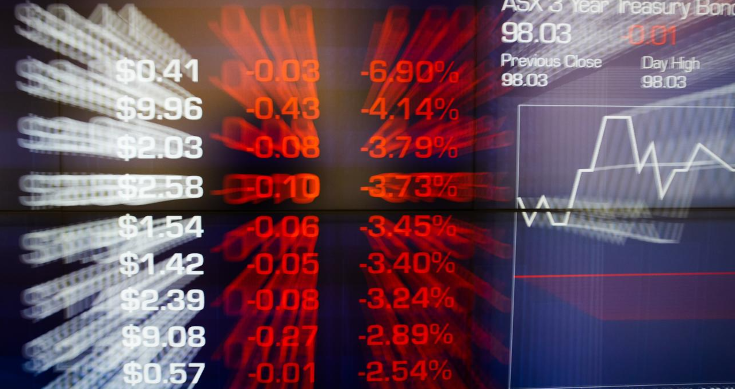by Melissa Darmawan
More pain for investors as a wave of selling on recession and inflation fears exacerbated by profit misses from retail giants Target and Walmart hit US markets, with the S&P/ASX 200 closing 1.7 per cent or 118 points lower at 7,065, ending its four day winning streak.
The morning kicked off with a steep fall of 1.8 per cent ahead of the jobs data for April, and struggled to recover ground the entire session.
When it did come out, the 3.9 per cent unemployment rate was the lowest since August 1974 with just 4,000 new jobs created versus market estimates of 30,000 as a surge in full-time jobs was partly offset by a fall in part-time positions.
The numbers pushed the Aussie dollar above 69.5 cents against the greenback, with news that Shanghai is slated to allow more businesses in zero-Covid areas to resume normal operations from June as hopes for a much-needed rebound grow on consumer demand also helping sentiment.
This week investors also combed through the minutes of the Reserve Bank of Australia’s May meeting, which indicated that the board was prepared to raise the cash rate by up to 40 basis points to crimp inflation.
The latest jobs figures prompted economists to forecast the next rate hike to be at 40 basis points to 0.75 per cent in June, eventually hitting 2.25 per cent next year.
The risk-averse mood meant that the sell-off extended almost across the board. A handful of gold players did manage to buck the trend, with Evolution Mining (ASX:EVN) adding 2 per cent at $3.50 in the flight to safety. Defensive healthcare was another outlier, adding 0.1 per cent.
Not so consumer staples and discretionary, which lost 3.7 and 3.1 per cent respectively, while information tech took it on the chin again, clocking a 2.7 per cent fall. Utilities were slightly better off, with the sector shedding just 0.5 per cent.
Bunnings owner and conglomerate Wesfarmers (ASX:WES) plummeted 7.8 per cent to $45.89 as the second worst performer in the ASX 200. Woolworths (ASX:WOW) tumbled 5.6 per cent to $35.18 while Metcash (ASX:MTS) dived 6.5 per cent to $4.29
Among discretionary players, JB Hi-Fi (ASX:JBH) lost 6.6 per cent to $44.89, Super Retail Group (ASX:SUL) fell 6 per cent to $9.35 while Harvey Norman (ASX:HVN) closed 5.5 per cent lower to $4.33.
Webjet (ASX:WEB) returned to profitability in the year ending in March but results fell short of consensus estimates due to corporate costs coming in 16 per cent higher at $15.6 million. Despite RBC capital market analyst Wei-Weng Chen warning of a further 22 per cent upside to costs in financial year 2023, dip buyers emerged taking the shares from a fall of almost 3 per cent today to a closing gain of 1.4 per cent to $5.87. Flight Centre (ASX:FLT) dived 4.7 per cent to $20.22, while Qantas (ASX:QAN) closed 1.1 per cent lower to $5.46.
Westpac Banking Corporation (ASX:WBC) led the banks lower by 4 per cent to $23.45 while BHP (ASX:BHP) tumbled 1.7 per cent to $46.23.
There were a few stock standouts.
Despite base metal prices continuing their slide Galileo Mining (ASX:GAL) has more than tripled this year and today saw more of the same, closing at session highs, adding 16.7 per cent to $1.08.
Aristocrat Leisure (ASX:ALL) posted a 41 per cent rise in normalised profit after tax and before amortisation of $562 million from a year ago, beating Bloomberg’s estimate by over 16 per cent. Aristocrat plans to return up to $500 million to investors through an on-market share buyback, after raising $1.3 billion for its failed takeover bid of UK gaming software company Playtech. Eligible shareholders are set to receive an interim dividend of 26 cents per share in July, almost 75 per cent up from the year before. Shares jumped 6.7 per cent to close at $33.73.
Even with today’s big fall, investors remain unsure where the bottom of the market is in this sea of red.
In Asian markets, Chinese tech stocks plummeted with Tencent losing more than 8 per cent after the tech behemoth posted its slowest revenue growth since going public in 2004.
Futures
The Dow Jones futures are pointing to a fall of 56 points.
The S&P 500 futures are pointing to a fall of 8 points.
The Nasdaq futures are pointing to a fall of 47 points.
The SPI futures are pointing to a fall of 113 points when the market next opens.
Best and worst performers
The best-performing sector was healthcare, up 0.1 per cent. The worst-performing sector was consumer staples, down 3.7 per cent.
The best-performing stock in the S&P/ASX 200 was Imugene (ASX:IMU), closing 17.7 per cent higher at $0.20. It was followed by shares in Aristocrat Leisure (ASX:ALL) and PolyNovo (ASX:PNV).
The worst-performing stock in the S&P/ASX 200 was Nufarm (ASX:NUF), closing 8.6 per cent lower at $6.07. It was followed by shares in Wesfarmers (ASX:WES) and Pendal Group (ASX:PDL).
Asian markets
Japan’s Nikkei has lost 1.9 per cent.
Hong Kong’s Hang Seng has lost 2.6 per cent.
China’s Shanghai Composite has lost 0.2 per cent.
Commodities and the dollar
Gold is trading at US$1814.35 an ounce.
Iron ore is 2.7 per cent lower at US$126.60 a ton.
Iron ore futures are pointing to a fall of 0.4 per cent.
Light crude is trading $0.93 higher at US$107.97 a barrel.
One Australian dollar is buying 69.90 US cents.
Sources: Bloomberg, FactSet, IRESS, TradingView, UBS, Bourse Data, Trading Economics, Australian Bureau of Statistics














